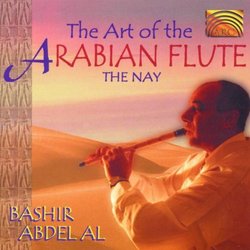| All Artists: Bashir Abdel Al Title: Art of the Arabian Flute-The Nay Members Wishing: 0 Total Copies: 0 Label: Arc Music/Naxos Original Release Date: 1/1/1999 Re-Release Date: 1/26/1999 Album Type: Import Genres: Folk, International Music Styles: Traditional Folk, Africa, Middle East Number of Discs: 1 SwapaCD Credits: 1 |
Search - Bashir Abdel Al :: Art of the Arabian Flute-The Nay
 | Bashir Abdel Al Art of the Arabian Flute-The Nay Genres: Folk, International Music
|
Larger Image |
CD Details |
CD ReviewsVery good Nay, but shame on the rest! AA | Newton, MA United States | 09/22/2000 (2 out of 5 stars) "The Nay music is outstanding, but the accompanying music mostly keyboards and ultra modern sounds just don't fit at all and detracts from the excellent nay. Oh, well, what a shame to spoil such excellent music!" Chilling and Beautiful Ali | 08/14/2005 (4 out of 5 stars) "The "ney" is a Persian (Iranian) instrument which dates back to thousands of years before Christ. It is made from reed, and the word "ney" is a Persian word that means "reed." The name for this instrument, and probably the instrument itself, was introduced into Arabic court upon the invasion of the Arabs into Persia (Iran) in the 7th century AD. It was also introduced into Turkish court upon the Ottoman Turk's invasion of Persia. Once it was introduced to Arabic and Turkish court, the name of this instrument was adopted from the Persian language into both the Arabic language and the Turkish language. The Persian style of playing this instrument is different from Turkish and Arabic styles. The Arabic-style ney music played on this CD is chilling and beautiful. A brief word on history must be made here because it is related to this instrument: When Arabs invaded Iran, Arabic became the official written language. Many Persians changed their names into Arabic names. The Arabs enforced their religion upon each country they invaded, including a Zoroastrian (Zoroastrianism: first monotheistic religion in the world) Iran, and called their declared land the "Islamic World." Iranian court musicians, who had changed their names to Arabic names because the Arabic language became the official language, composed music for the now Arab court and the Arab's "Islamic World." Thus, Arabic music, as recent studies have discussed, is the creation of Iranian court composers. It must be said that the Arabic language didn't last as the official language, and Parsi (or Farsi, the Persian language spoken from the Iranian-Sassanid era alongside Pahlavi and the official language of Iran today) became the official language once again. Anyway, The Iranian musicians, who composed music for Arab court, used a system that was created by several Iranian court musicians of the Sassanid Dynasty of Iran and was passed down to them in an oral tradition from their masters. And these masters learned from their own masters. This Iranian musical system was a complex system of 365 melodies that branched from 30 derivative modes which themselves branched from several modes. Iranian musicians also introduced this system into Turkish music. Iranian musical instruments were also introduced to Arabic countries, Turkey, and even India. It is because of Iranian musicians and the music of the Sassanid Iranians that we see the names of Iranian modes and melodies within Turkish Classical, Iraqi Classical, Syrian Classical, and Egyptian Classical music. Though these countries went their own way in regards to music, while Iran went its own way. This musical system was banned by some Arab-Islamists and by Iranian fanatics who had converted to Islam because of the Arabs. But the music was practiced and taught in secrecy. Later, during the Qajar era in Iran, the Sassanid system was revived, rejuvenated and officially re-established as the "Radif" and "Dastgah" system within the court and was used, for the first time, outside of court as well. Because of those fanatics, the system was hurt but never forgotten. There are now 12 modes (Dastgah) and 200 movements or melodies (Gushe) in Iranian Classical music. Most of these melodies and modes date back to that Sassanid era of Iran which had is responsible for inspiring the creation of Arabic and Turkish court music through those Iranian musicians mentioned above. Because of the evolving nature of music, some melodies were added along the way and some were altered. And, although the classical music of Turkey, Egypt, Syria, and Iraq were influenced by Iranian music-culture, they evolved on their own separate path and they bare their own separate characteristics. However Iranian classical music functions completely within the ancient Iranian modal system. ..." Music to trance by Expat abroad | Europe | 01/23/2005 (5 out of 5 stars) "The Arabian nay or ney is one of the most haunting flutes you'll ever hear, and Bashir Abdel Al is a master. His breath control is mesmerizing in the dreamlike pieces - though he can be crisp when the music calls for it - and the range of tones and style and volume is always amazing.
Far from detracting from the nay's melody, the (minimal) accompanying keyboard supports and deepens the song with few well-chosen, sustained chords. This is an excellent harmony of instruments. I dare anyone to resist introspection on any of the shorter OR longer tracks (varying from 3:02 to 12:00). The keyboard player is not credited, but Ivor Goldberg is listed as co-composer on many of the tracks... so perhaps? This CD is perfect for (just about ;) everyone who knows or is discovering the nay: sufficient classical elements for purists and an overall contemplative feel for anyone who likes New Age or world music." |

 Track Listings (7) - Disc #1
Track Listings (7) - Disc #1